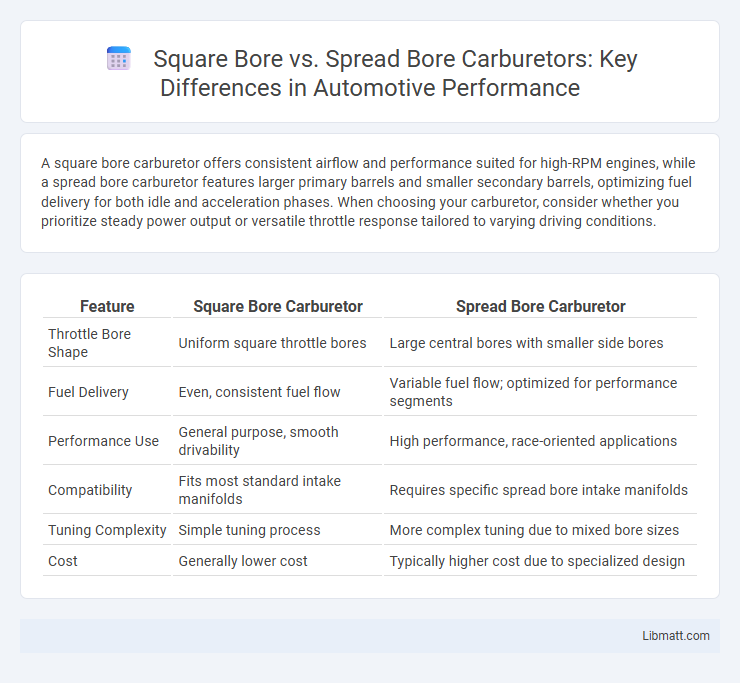A square bore carburetor offers consistent airflow and performance suited for high-RPM engines, while a spread bore carburetor features larger primary barrels and smaller secondary barrels, optimizing fuel delivery for both idle and acceleration phases. When choosing your carburetor, consider whether you prioritize steady power output or versatile throttle response tailored to varying driving conditions.
Table of Comparison
| Feature | Square Bore Carburetor | Spread Bore Carburetor |
|---|---|---|
| Throttle Bore Shape | Uniform square throttle bores | Large central bores with smaller side bores |
| Fuel Delivery | Even, consistent fuel flow | Variable fuel flow; optimized for performance segments |
| Performance Use | General purpose, smooth drivability | High performance, race-oriented applications |
| Compatibility | Fits most standard intake manifolds | Requires specific spread bore intake manifolds |
| Tuning Complexity | Simple tuning process | More complex tuning due to mixed bore sizes |
| Cost | Generally lower cost | Typically higher cost due to specialized design |
Introduction to Carburetors: Square Bore vs Spread Bore
Square bore carburetors feature throttle bores of equal size, typically 1.75 to 2 inches, optimizing airflow for moderate performance engines and providing balanced throttle response. In contrast, spread bore carburetors have larger central bores flanked by smaller outer bores, enhancing fuel atomization and distribution for improved high-performance applications. Both designs influence engine efficiency and power delivery by altering air-fuel mixture flow dynamics.
Design Differences: Square Bore and Spread Bore Explained
Square bore carburetors feature four equally sized rectangular throttle bores, providing uniform airflow ideal for high-performance engines demanding consistent fuel delivery. Spread bore carburetors have two larger primary bores and two smaller secondary bores, optimizing fuel efficiency by using smaller bores for low-speed cruising and larger bores for high-speed power. The design difference directly impacts throttle response, fuel atomization, and engine performance across various RPM ranges.
Performance Comparison: Power and Efficiency
Square bore carburetors deliver enhanced airflow and fuel atomization, resulting in improved high-RPM power and throttle response compared to spread bore carburetors. Spread bore designs offer better low-to-mid RPM fuel distribution, optimizing fuel efficiency and drivability for everyday use. Your choice depends on whether maximizing peak engine performance or achieving balanced fuel economy is the priority.
Fuel Delivery and Airflow Characteristics
Square bore carburetors feature uniform, rectangular throttle bores that enhance precise fuel metering and consistent airflow, optimizing fuel atomization and throttle response. Spread bore carburetors have larger primary bores alongside smaller secondary bores, enabling variable airflow and fuel delivery, which improves low-end torque and high RPM performance by adjusting fuel mixture dynamically. Fuel delivery in square bore designs remains stable across RPM ranges, while spread bore setups offer greater adaptability for diverse driving conditions through their staged airflow control.
Application Suitability: Street, Race, and Off-Road
Square bore carburetors excel in high-performance applications, particularly in racing and off-road vehicles, due to their ability to provide large volumes of air-fuel mixture at high RPMs. Spread bore carburetors offer better fuel atomization and throttle response, making them ideal for street vehicles where drivability and fuel efficiency are prioritized. In off-road settings, the square bore design supports rapid throttle changes and power delivery, while spread bore models balance performance with smoother operation.
Compatibility with Intake Manifolds
Square bore carburetors feature a uniform bore size that fits intake manifolds designed specifically for square bore applications, ensuring a tight seal and optimal airflow. Spread bore carburetors have larger outer bores and a smaller center bore, requiring intake manifolds engineered to accommodate this shape for proper alignment and fuel delivery. Compatibility between carburetor and intake manifold types is crucial for engine performance, as mismatches can lead to air leaks, incorrect fuel mixture, or mounting difficulties.
Tuning and Maintenance Requirements
Square bore carburetors demand precise tuning due to their uniform throttle bore size, making them ideal for consistent airflow but requiring regular adjustments to maintain optimal fuel delivery. Spread bore carburetors offer easier maintenance with simpler jet changes and less frequent tuning needs, thanks to their varied bore sizes that accommodate a wider range of performance setups. Your choice impacts the complexity and frequency of maintenance, with square bore models favoring more hands-on tuning for peak performance.
Cost and Availability of Each Carburetor Type
Square bore carburetors generally cost more due to their specialized design and better airflow capabilities, which suit high-performance engines. Spread bore carburetors are typically more affordable and widely available, as they have been mass-produced for a range of stock and mild performance applications. Availability of square bore carburetors may be limited to performance auto parts suppliers, whereas spread bore options can be found in most general automotive and restoration parts stores.
Pros and Cons: Square Bore vs Spread Bore
Square bore carburetors offer better airflow and throttle response, making them ideal for high-performance engines, but they tend to consume more fuel and can be less efficient at low speeds. Spread bore carburetors provide improved fuel economy and smoother idle due to their smaller primary bores and larger secondary bores, yet they may lack the immediate power delivery favored in racing applications. Your choice should depend on whether you prioritize performance and throttle response or fuel efficiency and smoother operation.
Choosing the Right Carburetor for Your Engine
Choosing the right carburetor for your engine depends on factors like engine size, fuel efficiency, and performance needs. Square bore carburetors provide better low-end torque and fuel atomization, making them ideal for smaller engines or daily driving. Spread bore carburetors offer improved high RPM airflow and horsepower, suited for larger engines or performance applications, ensuring you match your carburetor to your specific engine requirements.
Square Bore Carburetor vs Spread Bore Carburetor Infographic

 libmatt.com
libmatt.com